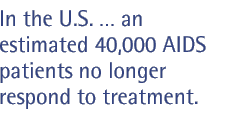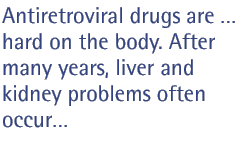How is HIV treated? | What are the drugs? | What is a typical HIV treatment regimen like? | What are the side effects? | Why aren't the drugs a cure? | Does a "superstrain" exist? | What is "salvage therapy"?
How is HIV treated?
There are two ways of treating HIV/AIDS:

- Treating the "opportunistic infections" that arise when a person's immune system is damaged: These treatments usually include antibiotics and other common drugs.
- Attacking the HIV itself with drugs that interfere with the virus's ability to reproduce itself.
As soon as HIV was discovered, scientists began to test drugs already approved to treat other conditions to see if any of them would have an effect on the virus. They soon discovered that one did make a difference: Zidovudine, known as AZT, stopped the action of an enzyme known as reverse transcriptase and slowed the progression of the virus remarkably -- but only for a little while. The virus then roared back to life as if the drug weren't even there; it had mutated and could survive the drug's presence. Even when given an additional reverse transcriptase inhibitor to block the mutated form of the virus, patients didn't stay healthy for long. Something more was needed.
Having experimented with using two drugs in combination, scientists in several labs came up with the idea of adding another drug to the arsenal. Researchers, including Dr. Roy Gulick, Dr. David Ho, Dr. John Mellors and several others, thought a multipronged approach, which worked for other rapidly mutating microbes like tuberculosis, might be the answer. By 1996, the first two protease inhibitors were approved by the FDA. Protease inhibitors stop the virus from forming mature virions, or individual virus particles.
Watch an animation from Johns Hopkins University that shows where the drugs work in HIV's life cycle.
Protease inhibitors seemed to work miracles when used in combination with two reverse transcriptase inhibitors. When combination therapy was introduced in 1996, the result came to be known as the "Lazarus effect": Patients who had been on the verge of death got out of bed, gained weight and went back to work. Ho was named Time magazine's "Man of the Year" and hailed as a pioneer of what became known colloquially as the "triple cocktail."
The secret to the triple cocktail was really all about the odds: After computing HIV's replication and mutation rates, researchers used mathematical modeling to determine that it was unlikely that the virus could simultaneously mutate around three drugs at once.
What are the drugs?
There are three classes of drugs currently on the market:
- Reverse transcriptase inhibitors stop viral RNA from being turned into DNA. There are two types -- nucleoside and non-nucleoside -- which target slightly different parts of the enzyme.
- Protease inhibitors prevent the new virions from cutting their enzymes into usable pieces.
- Fusion inhibitors stop HIV from entering CD4 cells in the first place.
Two versions of a fourth class of drugs, called integrase inhibitors, which stop viral DNA from being inserted into the T-cell's DNA, are currently in late-stage clinical trials and have shown promising results.
What is a typical HIV treatment regimen like?
Patients are on at least three drugs at once. Some need to be taken once a day, some twice. Some need to be taken with food, and some without. It's much more complicated than an ordinary course of antibiotics and timing is vital: Without consistent levels of medicine in a person's body, HIV will seize the opportunity to mutate around the drugs. Patients are also often on many other medications to combat the side effects of the antiretroviral drugs.
See a complete list of HIV drugs from Project Inform, a treatment advocacy organization.
What are the side effects?
Immediate and persistent side effects of the drugs can include fatigue, nausea and consistent diarrhea. Some drugs, especially AZT, seem to make certain individuals (especially African American women) more at risk for anemia. Other possible side effects include bone problems, sexual dysfunction, and insomnia.

After several years of treatment, lipoatrophy and lipodystrophy can become a problem. Lipoatrophy, often called wasting, means that fat is stripped out of a particular area of the body. Many people with HIV experience facial wasting, which leaves their faces gaunt and skeletal, making them look much sicker than they actually are. It can also happen in the legs and buttocks.
Lipodystrophy means that fat collects in unusual areas. Some individuals see their bellies or breasts get much bigger. Others get large deposits of fat in a hump on their back. Some people with HIV experience both lipodystrophy and lipoatrophy -- their legs may be super-skinny, but their abdomens will be fat.
Because antiretroviral drugs are very powerful, they are hard on the body. After many years, liver and kidney problems often occur in patients. Recently, doctors have also seen an increase in middle-aged HIV patients suddenly dying of heart failure. They speculate that the HIV drugs that cause unusual fat movement may also cause heart problems.
Why aren't the drugs a cure?
Even the powerful triple cocktail drugs don't completely stop HIV from replicating and mutating. Although the drugs prolong the time it takes HIV to circumvent treatment, eventually the virus will adapt. Resistance can appear in three to five years -- even earlier if a person misses doses.
When resistance occurs, patients can switch drug regimens to so-called "second-" and "third-line" options. But with only 26 HIV medications currently available (as of May 2006), an individual with HIV can run out of options. On average, antiretroviral treatment, available since 1996, has extended life eight years, although some patients are doing very well 10 years into therapy.
Does a "superstrain" exist?
In 2005, the media hyped the discovery of a "superstrain" of HIV, which allegedly progressed to AIDS in a matter of months, and was impervious to drug treatment. The truth is a bit more complicated. A patient, who had reported multiple unprotected sexual encounters with gay men, was diagnosed at New York's Aaron Diamond AIDS Research Center with three-drug-class-resistant HIV (3DCRHIV). His virus was resistant to two kinds of reverse transcriptase inhibitors and protease inhibitors. Because it was so difficult to treat, his infection progressed quickly to AIDS.
Scientists interviewed for FRONTLINE said the superstrain fear-mongering was overblown, but that multidrug-resistant viruses are beginning to be a problem. If two people with different strains of HIV infect each other again, the viruses can recombine, and increase the chances of both viruses becoming multidrug resistant. When people acquire drug-resistant strains of HIV, their treatment options are limited from the beginning.
What is "salvage therapy"?
When a patient nears the end of his or her available drug options, it means the virus in that person's body is resistant to several different drug classes. As a last option, known as "salvage therapy," doctors may use whatever drugs still have an impact on the virus, even if they offer only a small benefit. Some individuals who have been taking the drugs since they became available in 1996 are reaching the end of their options and more and more will end up on salvage therapy in the coming years if new drugs don't become available. In the United States, where antiretrovirals have been available longer than anywhere else, an estimated 40,000 people with AIDS no longer respond to treatment.



